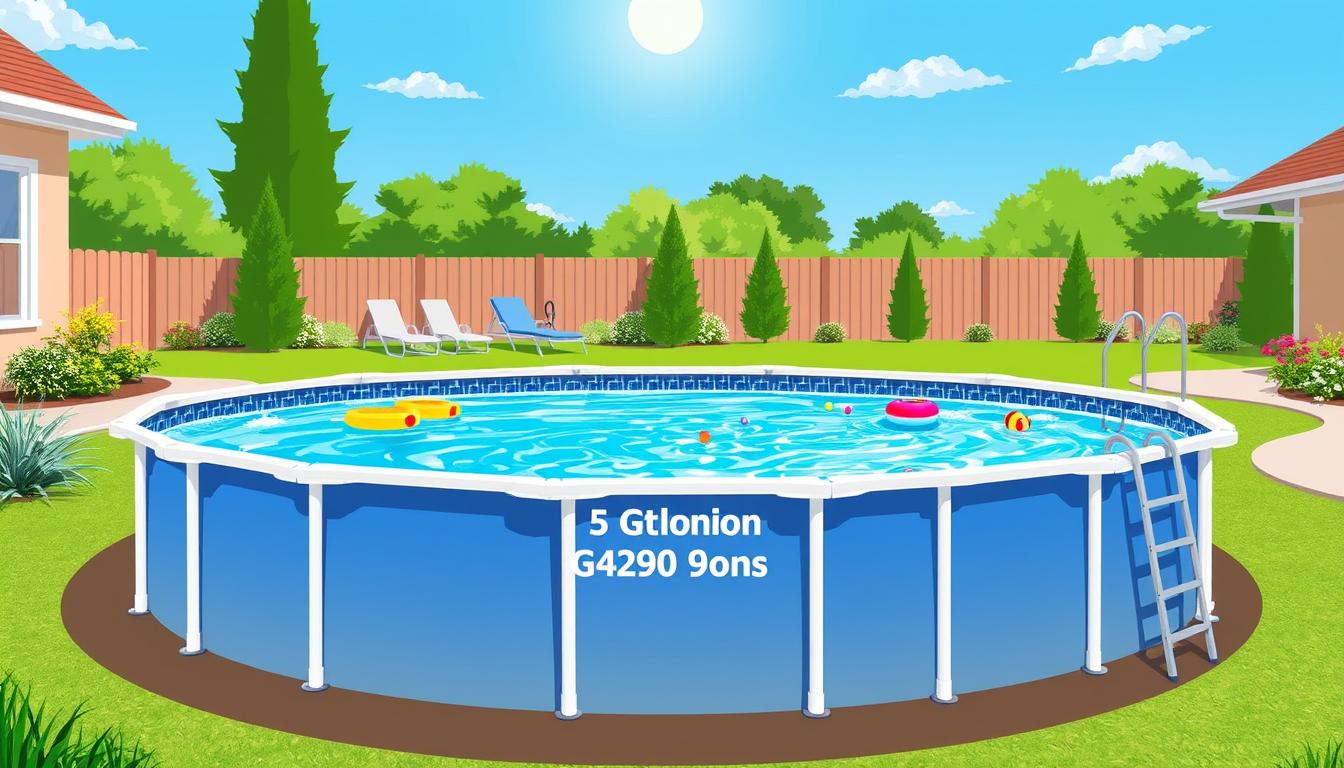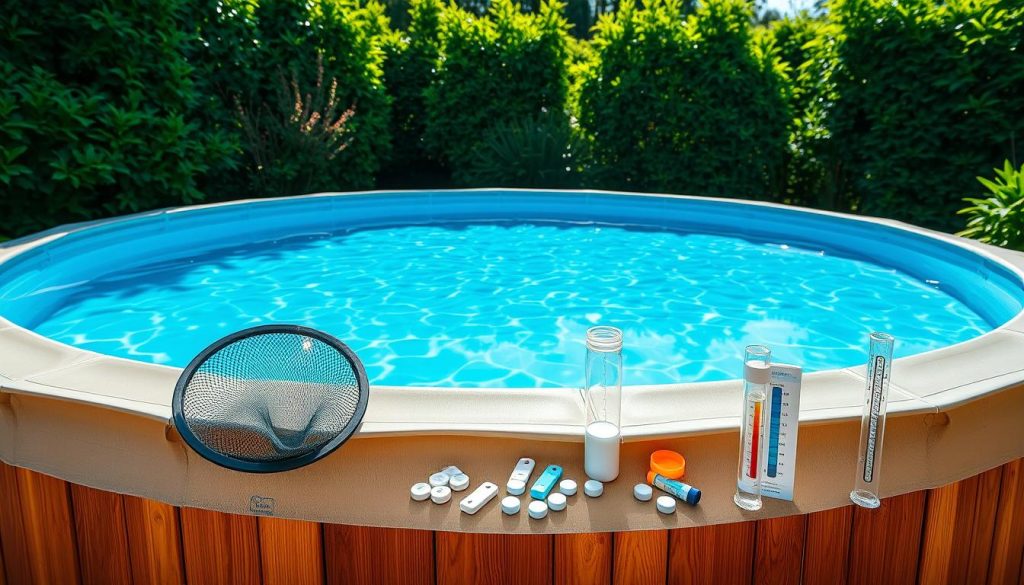
Ever wonder how much water your above ground pool holds? Knowing your pool’s capacity is key for proper maintenance. It helps balance chemicals, ensure efficient heating, and keep your pool safe.
This guide will help you calculate your pool’s volume easily. You’ll learn about different above ground pool sizes and how to measure them.
Your pool’s gallon count matters for several reasons. It helps you use the right amount of chemicals and optimize filtration. You can also make smart choices about energy use and costs.
By the end, you’ll know how to assess your pool’s volume. This knowledge will improve your pool maintenance routine.
Key Takeaways
- Above ground pool capacity varies based on pool size and shape.
- Calculating pool water volume is essential for proper maintenance and treatment.
- Round and oval pools have different formulas for determining gallon count.
- Factors like average depth and wall height impact the total volume of water.
- Understanding your pool’s gallon capacity can help optimize chemical balance, filtration, and energy efficiency.
Understanding Pool Gallons and Why They Matter
Knowing your pool’s water volume is vital for proper maintenance. It helps with water quality, heating, and filtration. Accurate pool gallon knowledge aids in making smart choices about pool care.

The Significance of Pool Gallons
Precise pool gallon measurement ensures proper chemical treatment. It prevents water imbalances that can cause irritation and equipment damage. Knowing your pool’s capacity helps maintain a safe, enjoyable swimming environment.
Pool water needs vary based on size and shape. The table below shows recommended chemical levels for a healthy pool:
| Chemical Parameter | Recommended Level |
|---|---|
| pH | 7.4–7.6 |
| Total Alkalinity | 80–120 ppm |
| Calcium Hardness | 200–400 ppm |
| Cyanuric Acid | 30–50 ppm |
| Free Chlorine | 1–4 ppm |
| Total Chlorine | Within 0.3 ppm of Free Chlorine level |
Impact on Maintenance, Treatment, and Enjoyment
Pool gallon knowledge is crucial for heating efficiency. It helps choose the right heater size to maintain comfortable water temperature. Proper sizing optimizes energy use and reduces operating costs.
Understanding water volume is key for effective filtration cycles. It allows adjusting the system’s runtime for optimal water clarity. This ensures thorough cleaning without wasting energy.
Knowing your pool’s gallon capacity is essential for proper maintenance and enjoyment. It leads to informed decisions about water care, resulting in a cleaner, safer pool experience.
Calculating Your Above Ground Pool’s Gallons
To find your above ground pool’s water capacity, you need to know its dimensions and shape. Round and oval are the most common shapes. Let’s learn how to calculate gallons for each shape using simple formulas.
Formula for Round Pools
For round above ground pools, use this formula to calculate water volume:
Volume = π x radius² x depth x 7.48
Find the radius by dividing the pool’s diameter by 2. Measure depth in feet for results in gallons. Use average depth for pools with sloped bottoms.
Formula for Oval Pools
Oval above ground pools need a different formula:
Volume = length x width x average depth x 7.48
Measure length and width in feet. Calculate average depth for sloped bottoms. Multiply all values together, then by 7.48 for gallons.
Practical Examples and Common Pool Sizes
Here are some common above ground pool sizes and their water capacities:
- A 15′ round pool with a 48″ wall height holds approximately 4,978 gallons
- An 18′ round pool with a 52″ wall height holds about 8,602 gallons
- A 24′ round pool with a 52″ wall height holds roughly 14,364 gallons
- A 15′ x 30′ oval pool with a 52″ wall height holds approximately 14,364 gallons
- An 18′ x 33′ oval pool with a 54″ wall height holds about 19,156 gallons
These examples show how water capacity varies based on pool sizes and shapes. Always double-check your measurements for accurate results when determining your pool’s volume.
Knowing your pool’s gallon count helps with maintenance tasks like chemical treatments and water replacement. It also aids in planning energy costs for heating and filtration.
Accurate volume calculations ensure your pool stays clean, safe, and enjoyable all season long.
how many gallons in above ground pool
Curious about gallon amounts for different above ground pool sizes? Our chart helps you find your pool’s water capacity. This info helps with water chemistry, bills, and proper filling.
Knowing your pool’s gallon capacity is key for a healthy swimming environment. It’s the first step in maintaining your pool correctly.
Table of Gallon Amounts by Pool Size and Shape
| Pool Size | Shape | Wall Height | Gallons |
|---|---|---|---|
| 12′ x 24′ | Oval | 52″ | 8,600 |
| 15′ | Round | 52″ | 5,300 |
| 15′ x 30′ | Oval | 52″ | 11,500 |
| 18′ | Round | 52″ | 7,600 |
| 18′ x 33′ | Oval | 52″ | 14,000 |
| 21′ x 43′ | Oval | 54″ | 30,395 |
| 24′ | Round | 52″ | 14,652 |
| 27′ | Round | 52″ | 18,500 |
| 28′ x 16′ x 26′ | Oval | 54″ | 15,400 |
Factors Affecting Water Volume
The chart gives a good start, but other things can change your pool’s water volume. These factors can affect how much water is in your pool.
- Evaporation: Water naturally evaporates from your pool, especially during hot and dry weather conditions. This can lead to a gradual decrease in water levels over time.
- Splashing and play: When people are enjoying your pool, water is bound to splash out, contributing to water loss.
- Backwashing: If you have a sand or DE filter, the backwashing process uses water from your pool, which needs to be replaced.
- Leaks: Any leaks in your pool’s structure or plumbing can cause water levels to drop more quickly than normal.
Check your pool’s water level often. Top it off when needed. This helps keep your pool in good shape.
Conclusion
Knowing your above ground pool’s volume is key to successful pool ownership. Accurate calculations ensure proper maintenance, chemical dosing, and efficient filtration. This knowledge helps create a healthy swimming environment for everyone.
Understanding pool capacity aids in selecting the right equipment. It optimizes performance and energy efficiency. With proper tools, you can reduce maintenance costs and maximize pool enjoyment.
Calculating pool volume is simple, varying by shape and size. Use the provided formulas and table to determine your pool’s capacity. This information helps you make smart decisions about pool upkeep.
Pool volume knowledge is crucial for a safe, enjoyable swimming environment. With this info, you can confidently manage your backyard oasis. Your pool will remain a source of fun and relaxation for years.







